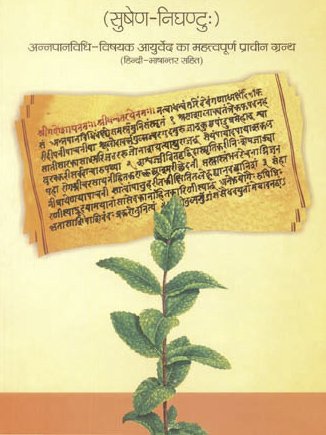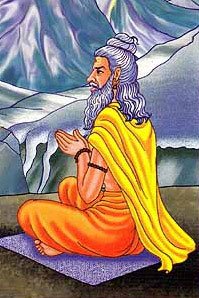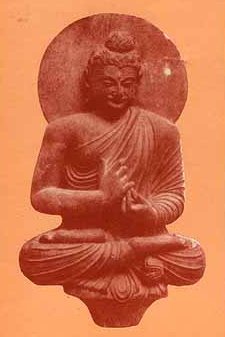Dhamani, Dhamanī, Dhāmanī: 22 definitions
Introduction:
Dhamani means something in Hinduism, Sanskrit, Buddhism, Pali, Marathi, Jainism, Prakrit, Hindi, biology. If you want to know the exact meaning, history, etymology or English translation of this term then check out the descriptions on this page. Add your comment or reference to a book if you want to contribute to this summary article.
In Hinduism
Ayurveda (science of life)
Nighantu (Synonyms and Characteristics of Drugs and technical terms)
Source: WorldCat: Rāj nighaṇṭuDhamanī (धमनी) is another name for Pṛśniparṇī, a medicinal plant identified with Uraria picta Desv. from the Fabaceae or “legume” family of flowering plants, according to verse 4.37-39 of the 13th-century Raj Nighantu or Rājanighaṇṭu. The fourth chapter (śatāhvādi-varga) of this book enumerates eighty varieties of small plants (pṛthu-kṣupa). Together with the names Dhamanī and Pṛśniparṇī, there are a total of twenty-four Sanskrit synonyms identified for this plant.
Unclassified Ayurveda definitions
Source: Google Books: Essentials of AyurvedaDhamanī (धमनी, “arteries”) are the channels which carry blood forcefully (pulsating) from heart to different organs. Sirā (‘veins’) are those which bring blood back to heart slowly. Between these two are keśikā (‘capillaries’) which spread like minute webs and through which, rasa (‘nutrient material or serum’) oozes to the tissues.

Āyurveda (आयुर्वेद, ayurveda) is a branch of Indian science dealing with medicine, herbalism, taxology, anatomy, surgery, alchemy and related topics. Traditional practice of Āyurveda in ancient India dates back to at least the first millenium BC. Literature is commonly written in Sanskrit using various poetic metres.
Purana and Itihasa (epic history)
Source: Cologne Digital Sanskrit Dictionaries: The Purana IndexDhamanī (धमनी).—The queen of Hrāda and mother of Vātāpi and Ilvala.*
- * Bhāgavata-purāṇa VI. 18. 15.

The Purana (पुराण, purāṇas) refers to Sanskrit literature preserving ancient India’s vast cultural history, including historical legends, religious ceremonies, various arts and sciences. The eighteen mahapuranas total over 400,000 shlokas (metrical couplets) and date to at least several centuries BCE.
General definition (in Hinduism)
Source: archive.org: Vedic index of Names and SubjectsDhamani (धमनि, ‘reed’) appears to denote ‘pipe’ in a passage of the Rigveda and in a citation appearing in the Nirukta. In the Atharvaveda it denotes, perhaps, ‘artery’ or ‘vein’, or more generally ‘intestinal channel’, being coupled in some passages with Hirā.
Biology (plants and animals)
Source: Wisdom Library: Local Names of Plants and DrugsDhamani in the Hindi language is the name of a plant identified with Grewia tiliifolia Vahl from the Tiliaceae (Phalsa) family having the following synonyms: Grewia arborea, Grewia rotunda, Grewia inaequalis. For the possible medicinal usage of dhamani, you can check this page for potential sources and references, although be aware that any some or none of the side-effects may not be mentioned here, wether they be harmful or beneficial to health.
Dhamani [धामणी] in the Marathi language is the name of a plant identified with Helicteres isora L. from the Sterculiaceae (Cacao) family.
Source: Google Books: CRC World Dictionary (Regional names)1) Dhamani in India is the name of a plant defined with Aglaia odorata in various botanical sources. This page contains potential references in Ayurveda, modern medicine, and other folk traditions or local practices It has the synonym Aglaia odorata var. microphyllina C. DC..
2) Dhamani is also identified with Grewia asiatica.
3) Dhamani is also identified with Grewia tiliaefolia It has the synonym Grewia tiliifolia A. Rich. (etc.).
4) Dhamani is also identified with Onosma echioides It has the synonym Cerinthe echioides L..
Example references for further research on medicinal uses or toxicity (see latin names for full list):
· Journal of Tree Sciences (1982)
· Journal of Natural Products (1996)
· Antiviral Research (2005)
· Nuov. Giorn. Bot. Ital. (1924)
· Species Plantarum (1762)
· Species Plantarum (1753)
If you are looking for specific details regarding Dhamani, for example health benefits, pregnancy safety, chemical composition, extract dosage, side effects, diet and recipes, have a look at these references.

This sections includes definitions from the five kingdoms of living things: Animals, Plants, Fungi, Protists and Monera. It will include both the official binomial nomenclature (scientific names usually in Latin) as well as regional spellings and variants.
Languages of India and abroad
Pali-English dictionary
Source: BuddhaSasana: Concise Pali-English Dictionarydhamani : (f.) a vein.
Source: Sutta: The Pali Text Society's Pali-English DictionaryDhamani, (f.) (Sk. dhamani, to dhamati, orig. a tube for blowing, a tubular vessel, pipe) a vein Th.1, 408. Usually in cpd.: —santhata strewn with veins, with veins showing, i.e. emaciated (: nimmaṃsa-lohitatāya sirājālehi vitthatagatta PvA.68) Vin.III, 110; J.IV, 371; V, 69; Dh.395=Th.1, 243=Pv.II, 113; Pv IV.101; DhA.I, 299, 367; IV, 157; ThA.80. So also in Jain Pk. “kisa dhamaṇisaṃtata”: Weber, Bhagavatī p. 289; cp. Lal. Vist. 226.—Also as °santhatagatta (adj.) having veins showing all over the body for lack of flesh Vin.I, 55; III, 146; M.II, 121; J.I, 346, II.283; ThA.80. (Page 335)

Pali is the language of the Tipiṭaka, which is the sacred canon of Theravāda Buddhism and contains much of the Buddha’s speech. Closeley related to Sanskrit, both languages are used interchangeably between religions.
Marathi-English dictionary
Source: DDSA: The Molesworth Marathi and English Dictionarydhamanī (धमनी).—f S A small tube through which to puff the fire. 2 Any tubular vessel of the body, as an artery, a vein, a nerve.
Source: DDSA: The Aryabhusan school dictionary, Marathi-Englishdhamanī (धमनी).—f An artery, a vein. A kind of carriage.
Marathi is an Indo-European language having over 70 million native speakers people in (predominantly) Maharashtra India. Marathi, like many other Indo-Aryan languages, evolved from early forms of Prakrit, which itself is a subset of Sanskrit, one of the most ancient languages of the world.
Sanskrit dictionary
Source: DDSA: The practical Sanskrit-English dictionaryDhamani (धमनि) or Dhamanī (धमनी).—f.
1) A reed, blow-pipe; वेणुधमन्या प्रबोध्य (veṇudhamanyā prabodhya) Vaiśvadeva.
2) A tube or canal of the human body, tubular vessel, as a vein, a nerve, &c.
3) Throat, neck.
4) A speech.
5) Turmeric.
Derivable forms: dhamaniḥ (धमनिः).
--- OR ---
Dhāmanī (धामनी).—See धमनी (dhamanī).
See also (synonyms): dhāmanikā.
Source: Cologne Digital Sanskrit Dictionaries: Shabda-Sagara Sanskrit-English DictionaryDhāmanī (धामनी).—f. (-nī) Any tubular vessel of the body: see dhamanī.
Source: Cologne Digital Sanskrit Dictionaries: Benfey Sanskrit-English DictionaryDhamani (धमनि).—[dham + anī] (vb. dhamā), f. A vein, Mahābhārata 1, 5936.
Dhamani can also be spelled as Dhamanī (धमनी).
Source: Cologne Digital Sanskrit Dictionaries: Cappeller Sanskrit-English DictionaryDhamani (धमनि).—[feminine] piping; reed, pipe; tube or canal of the human body, vessel, vein, nerve, etc.
Source: Cologne Digital Sanskrit Dictionaries: Monier-Williams Sanskrit-English Dictionary1) Dhamani (धमनि):—[from dhmā] f. the act of blowing or piping, [Ṛg-veda ii, 11, 8]
2) [v.s. ...] (also nī) a pipe or tube, ([especially]) a canal of the human body, any tubular vessel, as a vein, nerve etc., [Atharva-veda; Chāndogya-upaniṣad; Mahābhārata; Suśruta] etc. (24 t° vessels starting from the heart or from the navel are supposed to carry the raca or chyle through the body)
3) [v.s. ...] the throat, neck, [cf. Lexicographers, esp. such as amarasiṃha, halāyudha, hemacandra, etc.]
4) [v.s. ...] Name of Hrāda’s wife (the mother of Vātāpi and Ilvala), [Bhāgavata-purāṇa]
5) Dhamanī (धमनी):—[from dhamani > dhmā] f. a sort of perfume, [Bhāvaprakāśa]
6) [v.s. ...] turmeric or Hemionitis Cordifolia, [cf. Lexicographers, esp. such as amarasiṃha, halāyudha, hemacandra, etc.]
7) Dhāmanī (धामनी):—[from dhāmanikā] f. Hemionitis Cordifolia, [cf. Lexicographers, esp. such as amarasiṃha, halāyudha, hemacandra, etc.]
8) [v.s. ...] any tubular vessel of the body (= dhamani), [ib.]
Source: Cologne Digital Sanskrit Dictionaries: Yates Sanskrit-English Dictionary1) Dhamani (धमनि):—[(niḥ-nī)] 2. 3. f. Tubular vessel, as a vein; the neck; turmeric; a sort of perfume.
2) Dhāmanī (धामनी):—(nī) 3. f. Any tubular vessel of the body. Also dhamanī.
Source: DDSA: Paia-sadda-mahannavo; a comprehensive Prakrit Hindi dictionary (S)Dhamani (धमनि) in the Sanskrit language is related to the Prakrit words: Dhamaṇi, Dhamaṇī.
[Sanskrit to German]
Sanskrit, also spelled संस्कृतम् (saṃskṛtam), is an ancient language of India commonly seen as the grandmother of the Indo-European language family (even English!). Closely allied with Prakrit and Pali, Sanskrit is more exhaustive in both grammar and terms and has the most extensive collection of literature in the world, greatly surpassing its sister-languages Greek and Latin.
Hindi dictionary
Source: DDSA: A practical Hindi-English dictionaryDhamanī (धमनी):—(nf) an artery.
...
Prakrit-English dictionary
Source: DDSA: Paia-sadda-mahannavo; a comprehensive Prakrit Hindi dictionaryDhamaṇi (धमणि) in the Prakrit language is related to the Sanskrit word: Dhamani.
Prakrit is an ancient language closely associated with both Pali and Sanskrit. Jain literature is often composed in this language or sub-dialects, such as the Agamas and their commentaries which are written in Ardhamagadhi and Maharashtri Prakrit. The earliest extant texts can be dated to as early as the 4th century BCE although core portions might be older.
Kannada-English dictionary
Source: Alar: Kannada-English corpusDhamaṇi (ಧಮಣಿ):—[noun] a cart with a box-
--- OR ---
Dhamani (ಧಮನಿ):—
1) [noun] a long tube of clay, concrete, metal, plastic, etc., for conveying water, gas, oil, etc.; a pipe.
2) [noun] a hollow cylinder or cone, as of reed, straw.
3) [noun] any blood vessel in the body; a vein; a nerve.
4) [noun] that part of a human or animal joining the head to the body, including the part of the backbone between the skull and the shoulders; the neck.
Kannada is a Dravidian language (as opposed to the Indo-European language family) mainly spoken in the southwestern region of India.
See also (Relevant definitions)
Starts with (+1): Dhamanicaya, Dhamanidhi, Dhamaniga, Dhamaniharsha, Dhamanijalasamvrita, Dhamanijalasantata, Dhamanika, Dhamanila, Dhamanio, Dhamanipraticaya, Dhamanirajjusamtata, Dhamanisamtata, Dhamanisanthatagatta, Dhamanitata, Tamani, Tamanicculi, Tamanippinaiyal, Tamaniti, Tamaniyakkutam, Tamaniyam.
Ends with: Abhidhamani, Agnidhamani, Apadhamani, Candrardhamani, Cutamani, Harshadhamani, Jivitadhamani, Khad dhamani, Kiritadhamani, Mutrashaya-dhamani, Nagadamani, Nakatamani, Nigudhamani, Pitamani, Rameshvara adhvarasudhamani, Shuddhamani, Skandhamani, Tamani, Vardhamani.
Full-text (+6): Dhamanika, Jivasakshin, Dhamanisamtata, Dhamanirajjusamtata, Khad dhamani, Dhamaniga, Mutrashaya-dhamani, Sarapadapa, Mutrashay-dhamni, Dhamanila, Minmila, Dhamitra, Santhata, Minmina, Kisa, Hattavilasini, Vatapi, Vriddhi, Kanishthaka, Hrada.
Relevant text
Search found 17 books and stories containing Dhamani, Dhamanī, Dhāmanī, Dhamaṇi, Dhamaṇī; (plurals include: Dhamanis, Dhamanīs, Dhāmanīs, Dhamaṇis, Dhamaṇīs). You can also click to the full overview containing English textual excerpts. Below are direct links for the most relevant articles:
A History of Indian Philosophy Volume 2 (by Surendranath Dasgupta)
Part 10 - The Circulatory and the Nervous System < [Chapter XIII - Speculations in the Medical Schools]
Part 3 - Organs in the Atharva-veda and Āyurveda < [Chapter XIII - Speculations in the Medical Schools]
Part 6 - Foetal Development < [Chapter XIII - Speculations in the Medical Schools]
Sushruta Samhita, volume 3: Sharirasthana (by Kaviraj Kunja Lal Bhishagratna)
Chapter IX - The description of the arteries, nerves and ducts
Chapter IV - The development of a fetus in the womb
Rig Veda (translation and commentary) (by H. H. Wilson)
The Agni Purana (by N. Gangadharan)
Chapter 52 - Characteristics of images of different forms of goddesses
Chapter 364 - Words denoting men and the four classes of men
Charaka Samhita (English translation) (by Shree Gulabkunverba Ayurvedic Society)
Chapter 5 - Body-channels (srotas-vimana) < [Vimanasthana (Vimana Sthana) — Section on Measure]
Atharvaveda and Charaka Samhita (by Laxmi Maji)
Pāṇḍuroga (anemia) according to Caraka < [Chapter 4 - Diseases and Remedial measures (described in Caraka-saṃhitā)]